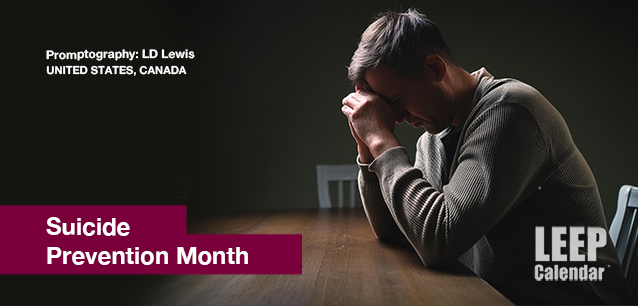 AD
AD
Today is: January 10
Scroll to explore events active on this date.
Additional Events on LEEP
LEEP INK FEATURES

Part II
There are several unique focuses for 2025. I covered the first 12 in Part One. The following are the rest I have discovered for this year. As with all issues of LEEP Ink, the following descriptions are a...

January—It is a New Year!
We've arrived at another new year; the older I get, the more frequently they come. When I was younger, years seemed to take a long time to pass. Now, they're just a blip—here and gone. For ma...

2025 is the Year of...
21 Themes and 'Year of' Events for 2025 PART ONE, THE FIRST 12 Every year, various organizations announce the theme for the year. These themes can focus on causes, such as aesthetics and color tre...
About Suicide Prevention Month
Safety & Security , Finance & Banking
Canada , United States
Ends: Sep 30, 2025
DESCRIPTION:
SUICIDE PREVENTION MONTH: A NATIONAL EFFORT TO SAVE LIVES
In the United States and Canada, dial 988 if you're experiencing a crisis.
Every September, the United States observes Suicide Prevention Month, a time dedicated to raising awareness about suicide and promoting efforts to prevent it. 988 Suicide and Crisis Lifeline (formerly the National Suicide Prevention Lifeline (NSPL)), along with the American Foundation for Suicide Prevention (AFSP), mental health organizations, and community groups organize the month. The campaign seeks to reduce the stigma surrounding mental health issues and provide support and resources for those in need.
The primary aim of Suicide Prevention Month is to increase awareness about the prevalence of suicide, educate the public about warning signs and risk factors, and promote mental health and well-being. The month-long campaign encourages individuals to reach out for help, offers resources for those struggling with suicidal thoughts, and provides training for recognizing and responding to suicide risks.
WHO IS MOST AT RISK FOR SUICIDE?
Suicide affects people of all ages, but certain groups are at higher risk. Statistics from the Centers for Disease Control and Prevention (CDC) provide insight into the prevalence of suicide across different age groups:
Ages 10-34—Suicide is the second leading cause of death.
Ages 35-44—The fourth leading cause of death.
Ages 45-54—The fifth leading cause of death.
Ages 55-64—The eighth leading cause of death.
Ages 65 and older—Although lower in rank, the rates are still significant, especially among older men.
WHY DO PEOPLE COMMIT SUICIDE?
Suicide is often the result of a complex interplay of factors, including:
Mental Health Disorders—Conditions such as depression, anxiety, and bipolar disorder are major risk factors.
Substance Abuse—Alcohol and drug abuse can exacerbate suicidal thoughts and behaviors.
Trauma and Abuse—A history of trauma, abuse, or significant loss can increase risk.
Chronic Pain and Illness—Ongoing physical pain or severe medical conditions can contribute to suicidal ideation.
Isolation and Loneliness—Social isolation and lack of support can lead to feelings of hopelessness.
Financial difficulties—While it is challenging to pinpoint the exact frequency with which financial situations lead to suicide, various studies and reports indicate a strong correlation between financial stress and increased risk of suicide.
FINANCIAL DIFFICULTIES AND SUICIDE
Economic Downturns: Periods of monetary crisis, such as recessions or the 2008 financial crisis, often see a rise in suicide rates. Financial instability, job loss, and housing insecurity during these times exacerbate mental health issues.
Debt and Financial Stress: High levels of personal debt and financial obligations can lead to chronic stress, anxiety, and depression, significantly increasing the risk of suicide, particularly in individuals facing bankruptcy or foreclosure.
Income Inequality: Studies have shown that regions with high levels of income inequality tend to have higher suicide rates. The stress and social comparison resulting from economic disparity can contribute to feelings of hopelessness.
Unemployment: Unemployment is a well-documented risk factor for suicide. The loss of income, identity, and purpose associated with unemployment can lead to severe emotional distress and suicidal thoughts.
According to the Centers for Disease Control and Prevention (CDC), financial stressors, including job and financial problems, are among the most commonly reported circumstances related to suicide.
A 2011 study published in the American Journal of Public Health found that individuals experiencing financial crises were more likely to report suicidal thoughts and attempts.
WARNING SIGNS SOMEONE IS SUICIDAL
Identifying warning signs that someone may be suicidal is crucial for providing timely support and intervention. Here are six key warning signs to watch for:
Expressing Hopelessness—Verbal cues or statements such as "I can't go on," "There's no way out," or "I have no reason to live" can indicate feelings of hopelessness or despair.
Withdrawal—Social isolation or withdrawal from friends, family, and activities once enjoyed can signal emotional distress.
Mood Swings—Severe or dramatic mood swings, including sudden calmness after a period of depression, can be a red flag.
Increased Substance Use—A noticeable increase in the use of alcohol or drugs may be a coping mechanism for emotional pain and a sign of suicidal ideation.
Giving Away Belongings—Giving away prized possessions or making arrangements for one's affairs can indicate a person is planning for their death.
Behavioral Changes—Engaging in risky or self-destructive behaviors, such as reckless driving or unsafe sexual activity, can be an indication of suicidal thoughts.
Recognizing these warning signs and reaching out with empathy, support, and professional help can make a significant difference in someone's life. If you or someone you know is in immediate danger, it's essential to seek help from a mental health professional or contact emergency services.
MOST COMMON METHODS OF SUICIDE
The methods used for suicide vary, but the most common ones in the United States include:
Firearms—The most frequently used method, particularly among males.
Suffocation—Including hanging, is the second most common method.
Poisoning—Often involves drug overdose and is more common among females.
Drowning—Less common but still significant.
Suicide Prevention Month serves as a crucial reminder of the importance of mental health and the need for ongoing support and intervention. The campaign aims to save lives and offer hope to those in despair by fostering open conversations, providing resources, and promoting awareness. Organizations like the National Suicide Prevention Lifeline and the American Foundation for Suicide Prevention remain committed to reducing the incidence of suicide and supporting those affected by it.
VIDEOS
SUPPORTING DOCUMENTS
Currently, this event does not have supporting documents.
ADDITIONAL IMAGES
Currently, this event does not have supporting images.
Where would you like to go now?
 AD
AD


/footer-logo.svg)
